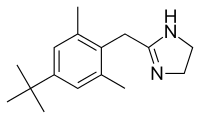Xylometazoline
Xylometazoline, also spelled xylomethazoline, is a medication used to reduce symptoms of nasal congestion, allergic rhinitis, and sinusitis.[1] Use is not recommended for more than seven days.[2] Use is also not recommended in those less than three months of age and some say not less than 6 years of age.[2][3] It is used directly in the nose as a spray or drops.[2]
 | |
| Clinical data | |
|---|---|
| Pronunciation | /ˌzaɪloʊˌmɛtəˈzoʊliːn/ ZY-lo-MET-ə-ZOH-leen |
| Trade names | Otrivin, Otrivine, others |
| AHFS/Drugs.com | Monograph |
| MedlinePlus | a608026 |
| License data | |
| Pregnancy category |
|
| Dependence liability | Moderate |
| Routes of administration | intranasal (spray or drops) |
| Drug class | α1 and α2 adrenergic receptor agonist |
| ATC code | |
| Legal status | |
| Legal status |
|
| Pharmacokinetic data | |
| Elimination half-life | >10 seconds |
| Excretion | Urinary |
| Identifiers | |
| |
| CAS Number | |
| PubChem CID | |
| IUPHAR/BPS | |
| DrugBank | |
| ChemSpider | |
| UNII | |
| KEGG | |
| ChEMBL | |
| CompTox Dashboard (EPA) | |
| ECHA InfoCard | 100.007.629 |
| Chemical and physical data | |
| Formula | C16H24N2 |
| Molar mass | 244.382 g·mol−1 |
| 3D model (JSmol) | |
| |
| |
| | |
Side effects include trouble sleeping, irritation of the nose, nausea, and headache.[1][2] Long term use is not recommended due to a rhinitis medicamentosa when stopped.[4] Use is not recommended during pregnancy.[1] Xylometazoline is in the decongestant and alpha-adrenergic agonist families of medication.[4][5]
Xylometazoline was patented in 1956 and came into medical use in 1959.[6] It is on the World Health Organization's List of Essential Medicines.[3] Xylometazoline is available as a generic medication.[2]
Mechanism of action
The drug works by stimulating adrenergic receptors on the lamina propria of blood vessels in the nose. The decongestant effect is due to constriction of large veins in the nose which swell up during the inflammation of any infection or allergy of the nose. The smaller arteries are also constricted and this causes the colour of the nasal epithelium to be visibly paler after dosage.
Xylometazoline is an imidazole derivative which is designed to mimic the molecular shape of adrenaline. It binds to α1 and α2 adrenergic receptors[7] in the nasal mucosa. Due to its sympathomimetic effects, it should not be used by people with high blood pressure, or other heart problems.
Extended usage of xylometazoline can result in decreased effectiveness or a buildup of tolerance against the drug.[8] The number of receptors decreases, and when the administration of the drug is ceased, chronic congestion can occur; this is called rhinitis medicamentosa, commonly referred to as rebound congestion. Moreover, long-term overdosing can cause degenerative changes in nasal mucous membranes that pose another health problem.
Society and culture
Brand names
Xylometazoline is sold under a number of brand names worldwide, including: Antazol (Square, in Bangladesh), Xylomet (Opsonin, Bangladesh) Cirovin, Klarigen (in Denmark), Nasolin, Neo-Rinoleina, Novorin, Olynth, Otrinoz, Otriven (Germany), Otrivin (Australia,[9] Canada, Estonia, Greece, Hungary, Israel, India,[10] Jordan, Netherlands, New Zealand, Norway, Poland, South Africa, Sweden, Vietnam), Galazolin[11] (Russia, Ukraine, Belarus), Otrivine (United Kingdom, Ireland, Turkey), Nasomist-X, Otrix, Rhinoset, Zenfresh, Naphthyzinium, Xymelyn (in Latvia), Sinutab Nasal Spray, Snup akut, Sudafed, Xylo-COMOD, Xylolin (in UAE), Xylovit, Olynth (in Serbia and Slovakia), Xynosine (in Pakistan, Afghanistan, Kyrgyzstan and Kazakhstan), Xymelin, Zymelin, Xylostar, Xylorin (in Poland), Nasobol, Xylo Mepha and others (Switzerland), Decozal (in Jordan), Nasic (Romania), Narhimed (Italy).
No products containing xylometazoline are currently marketed or available in the United States.[12]
Formulations
The standard adult solution strength is 0.1% w/v xylometazoline (or 1 mg per 1 mL solution), and the dose for children under 12 is usually 0.05% (0.5 mg/mL).[13]
See also
References
- "Otrivine Adult Measured Dose Sinusitis Spray - Summary of Product Characteristics (SPC) - (eMC)". www.medicines.org.uk. 13 April 2016. Archived from the original on 29 December 2016. Retrieved 28 December 2016.
- British national formulary : BNF 69 (69 ed.). British Medical Association. 2015. p. 786. ISBN 9780857111562.
- World Health Organization (2019). World Health Organization model list of essential medicines: 21st list 2019. Geneva: World Health Organization. hdl:10665/325771. WHO/MVP/EMP/IAU/2019.06. License: CC BY-NC-SA 3.0 IGO.
- Graf, P (1997). "Rhinitis medicamentosa: aspects of pathophysiology and treatment". Allergy. 52 (40 Suppl): 28–34. doi:10.1111/j.1398-9995.1997.tb04881.x. PMID 9353558.
- "Xylometazoline nasal medical facts from Drugs.com". www.drugs.com. Archived from the original on 29 December 2016. Retrieved 28 December 2016.
- Fischer, Janos; Ganellin, C. Robin (2006). Analogue-based Drug Discovery. John Wiley & Sons. p. 552. ISBN 9783527607495. Archived from the original on 29 December 2016.
- Haenisch, B.; Walstab, J.; Herberhold, S.; Bootz, F.; Tschaikin, M.; Ramseger, R.; Bönisch, H. (2009). "Alpha-adrenoceptor Agonistic Activity of Oxymetazoline and Xylometazoline". Fundamental & Clinical Pharmacology. 24 (6): 729–39. doi:10.1111/j.1472-8206.2009.00805.x. PMID 20030735.
- Gold Standard Clinical Pharmacology Archived 2008-05-25 at the Wayback Machine
- "xylometazoline". Healthdirect Australia. Retrieved 25 October 2019.
- "Otrivin | GSK Consumer Healthcare INDIA". Retrieved 17 June 2018.
- "Галазолин (Galazolin) - инструкция по применению, состав, аналоги препарата, дозировки, побочные действия". www.rlsnet.ru. Retrieved 5 August 2019.
- https://www.fda.gov/Drugs/DrugSafety/ucm325257.htm
- "Archived copy". Archived from the original on 22 February 2015. Retrieved 22 February 2015.CS1 maint: archived copy as title (link)